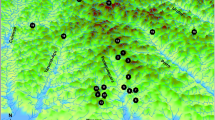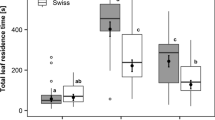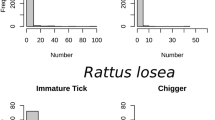Abstract
In Europe, both Maculinea alcon and M. teleius frequently co-occur inhabiting humid meadows. Although their parasitic life cycle is similar, ecological differences have been demonstrated between them: (i) spatial distribution of their eggs is different, and (ii) M. alcon is a cuckoo species, while M. teleius is predatory. The aim of the present study is to identify the genetic consequences of the ecological differences between these two butterfly species. To do so, we studied the genetic structure in samples from 9 M. alcon and 16 M. teleius sites obtained from the Carpathian Basin using 16 polymorphic enzyme markers. Both species exhibited relatively low enzyme polymorphism compared to other lycaenid species. Nevertheless, all measures of variation were significantly higher in M. teleius than in M. alcon. Genetic differentiation, however, was generally higher among M. alcon populations as compared to M. teleius. Moreover, the results of Bayesian clustering indicated a clear regional pattern with three well-defined cluster regions in M. alcon. In contrast, the regional pattern was less evident in M. teleius where we found three comparatively less distinct cluster regions. Putatively adaptive genetic differences were detected among cluster regions exploiting different host ants in M. alcon, while they were less evident in M. teleius. These results conform to our predictions on the differences between the utilization of their host ants. Since the pattern of genetic differentiation is different in the two Maculinea species, conservation strategies need also to differ in their cases.






Similar content being viewed by others
References
Aagaard K, Hindar K, Pullin AS, James CH, Hammarstedt O, Balstad T, Hanssen O (2002) Phylogenetic relationships in brown argus butterflies (Lepidoptera: Lycaenidae: Aricia) from north-western Europe. Biol J Linn Soc 75:27–37
Als TD, Nash DR, Boomsma JJ (2002) Geographical variation in host-ant specificity of the parasitic butterfly Maculinea alcon in Denmark. Ecol Entomol 27:403–414
Als TD, Vila R, Kandul NP, Nash DR, Yen SH, Hsu YF, Mignault AA, Boomsma JJ, Pierce NE (2004) The evolution of alternative parasitic life histories in large blue butterflies. Nature 432:386–390
Antao T, Lopes A, Lopes RJ, Beja-Pereira A, Luikart G (2008) LOSITAN: a workbench to detect molecular adaptation based on a F(st)-outlier method. BMC Bioinform 9:323
Barbero F, Jeremy A, Thomas JA, Bonelli S, Balletto E, Schönrogge K (2009) Queen ants make distinctive sounds that are mimicked by a butterfly social parasite. Science 323:782–785
Beaumont MA, Nichols RA (1996) Evaluating loci for use in the genetic analysis of population structure. Proc R Soc Lond Ser B-Biol Sci 263:1619–1626
Bereczki J, Pecsenye K, Peregovics L, Varga Z (2005) Pattern of genetic differentiation in the Maculinea alcon species group (Lepidoptera, Lycaenidae) in Central Europe. J Zool Syst Evol Res 43:157–165
Bereczki J, Pecsenye K, Varga Z (2006) Geographical versus food plant differentiation in populations of Maculinea alcon (Lepidoptera: Lycaenidae) in Northern Hungary. Eur J Entomol 103:725–732
Brookes MI, Graneau YA, King P, Rose OC, Thomas CD, Mallet JLB (1997) Genetic analysis of founder bottlenecks in the rare British butterfly Plebejus argus. Conserv Biol 11(3):648–661
Casacci LP, Barbero F, Balletto E (2014) The “evolutionarily significant unit” concept and its applicability in biological conservation. Ital J Zool 81(2):182–193
Cavalli-Sforza LL, Edwards AWF (1967) Phylogenetic analysis: models and estimation procedures. Am J Hum Genet 19:233–257
Czekes Z, Markó B, Nash DR, Ferencz M, Lázár B, Rákosy L (2014) Differences in oviposition strategies between two ecotypes of the endangered myrmecophilous butterfly Maculinea alcon (Lepidoptera: Lycaenidae) under unique syntopic conditions. Insect Conserv Divers 7:122–131
de Guia APO, Saitoh T (2007) The gap between the concept and definitions in the evolutionarily significant unit: the need to integrate neutral genetic variation and adaptive variation. Ecol Res 22:604–612
Dupont P (2010) Plan national d’actions en faveur des Maculinea. OPIE, Document de travail, p 131
Earl DA, von Holdt BM (2011) STRUCTURE HARVESTER: a website and program for visualizing STRUCTURE output and implementing the Evanno method. Conservation Genetics Resources. doi:10.1007/s12686-011-9548-7
Ebert G, Renwald E (1991) Die Schmetterlinge Baden-Württembergs. Eugen Ulmer GmbH, Stuttgart
Elmes GW, Thomas JA (1987) Die gattung Maculinea. In: Gieger W (ed) Tagfalter und ihre Lebensräume: Arten, Gefährdung, Schutz. Schweizerische Bund für Naturschutz, Basel, pp 354–368
Elmes GW, Thomas JA (1992) Complexity of species conservation in managed habitats—Interaction between Maculinea Butterflies and their ant hosts. Biodivers Conserv 1:155–169
Elmes GW, Thomas JA, Wardlaw JC (1991a) Larvae of Maculinea-rebeli, a large-blue butterfly, and their Myrmica host ants—wild adoption and behavior in ant-nests. J Zool 223:447–460
Elmes GW, Wardlaw JC, Thomas JA (1991b) Larvae of Maculinea-rebeli, a large-blue butterfly and their Myrmica host ants—patterns of caterpillar growth and survival. J Zool 224:79–92
Evanno G, Regnaut S, Goudet J (2005) Detecting the number of clusters of individuals using the software STRUCTURE: a simulation study. Mol Ecol 14:2611–2620
Felsenstein J (1985) Confidence limits on phylogenies: an approach using the bootstrap. Evolution 39:783–791
Figurny E, Woyciechowski M (1998) Flowerhead selection for oviposition by females of the sympatric butterfly species Maculinea teleius and M nausithous (Lepidoptera: Lycaenidae). Entomologia Generalis 23:215–222
Figurny-Puchalska E, Gadeberg RME, Boomsma JJ (2000) Comparison of genetic population structure of the large blue butterflies Maculinea nausithous and M-teleius. Biodivers Conserv 9:419–432
Francis B, Green M, Payne C (1994) GLIM 4. The statistical system of generalized linear interactive modelig. Oxford University Press, New York
Fraser DJ, Bernatchez L (2001) Adaptive evolutionary conservation: towards a unified concept for defining conservation units. Mol Ecol 10:2741–2752
Fric Z, Wahlberg N, Pech P, Zrzavy J (2007) Phylogeny and classification of the Phengaris-Maculinea clade (Lepidoptera: Lycaenidae): total evidence and phylogenetic species concepts. Syst Entomol 32:558–567
Funk WC, McKay JK, Paul A, Hohenlohe PA, Allendorf FW (2012) Harnessing genomics for delineating conservation units. Trends Ecol Evol 27(9):489–496
Fürst MA, Nash DR (2010) Host ant independent oviposition in the parasitic butterfly Maculinea alcon. Biol Lett 6:174–176
Gadeberg RME, Boomsma JJ (1997) Genetic population structure of the large blue butterfly Maculinea alcon in Denmark. J Insect Conserv 1:99–111
Goudet J (1995) Fstat version 1.2: a computer program to calculate F-statistics. J Hered 86:485
Habel JC, Schmitt T (2009) The genetic consequences of different dispersal behaviours in Lycaenid butterfly species. Bull Entomol Res 99:513–523
Hammer Ø, Harper DAT, Ryan PD (2006) PAST—Paleontological Statistics, version 1.56 Web site <http://folk.uio.no/ohammer/past>
Hochberg ME, Clarke RT, Elmes GW, Thomas JA (1994) Population dynamic consequences of direct and indirect interactions involving a large blue butterfly and its plant and red ant hosts. J Anim Ecol 63:375–391
Hollós A, Pecsenye K, Bereczki J, Bátori E, Varga Z (2012) Pattern of genetic and morphometric differentiation in Maculinea nausithous (Lepidoptera: Lycaenidae) in the Carpathian Basin. Acta Zool Hung 58:87–103
Höttinger H, Schlick-Steiner BC, Steiner FM (2003) The Alcon blue Maculinea alcon (Lepidoptera: Lycaenidae) in eastern Austria: status and conservation measures. Ekol-Bratisl 22:107–118
Kawecki TJ, Ebert D (2004) Conceptual issues in local adaptation. Ecol Lett 7:1225–1241
Kirsmann A (2000) Eiablageverhalten von Maculinea alcon ([D. and Sch.] 1775) an Gentiana pneumonanthe und Gentiana asclepiadea UFZ-Bericht, Leipzig
Kőrösi A, Örvössy N, Batáry P, Kövér S, Peregovits L (2008) Restricted within-habitat movement and time-constrained egg laying of female Maculinea rebeli butterflies. Oecologia 156:455–464
Mantel N (1967) The detection of disease clustering and a generalized regression approach. Cancer Res 27:209–220
Munguira ML, Martin J (1999) Action plan for the Maculinea butterflies in Europe. Council of Europe, Strasbourg
Nash DR, Als TD, Maile R, Jones GR, Boomsma JJ (2008) Mosaic of chemical coevolution in a large blue butterfly. Science 319:88–90
Nash DR, Als TD, Boomsma JJ (2011) Survival and growth of parasitic Maculinea alcon caterpillars (Lepidoptera, Lycaenidae) in laboratory nests of three Myrmica ant species. Insectes Soc 58:391–401
Nice CC, Shapiro AM (1999) Molecular and morphological divergence in the butterfly genus Lycaeides (Lepidoptera: Lycaenidae) in North America: evidence of recent speciation. J Evol Biol 12:936–950
Nowicki P, Witek M, Skorka P, Woyciechowski M (2005) Oviposition patterns in the myrmecophilous butterfly Maculinea alcon Denis and Schiffermuller (Lepidoptera: Lycaenidae) in relation to characteristics of foodplants and presence of ant hosts. Pol J Ecol 53:409–417
Peakall R, Smouse PE (2012) GenAlEx 6.5: genetic analysis in Excel. Population genetic software for teaching and research—an update. Bioinformatics 28:2537–2539
Pech P, Fric Z, Konvicka M, Zrzavy J (2004) Phylogeny of Maculinea blues (Lepidoptera: Lycaenidae) based on morphological and ecological characters: evolution of parasitic myrmecophily. Cladistics-the Int J Willi Hennig Soc 20:362–375
Pecsenye K, Bereczki J, Tihanyi B, Tóth A, Peregovits L, Varga Z (2007a) Genetic differentiation among the Maculinea species (Lepidoptera, Lycaenidae) in eastern Central Europe. Biol J Linn Soc 91:11–21
Pecsenye K, Bereczki J, Szilágyi M, Varga Z (2007b) High level of genetic variation in Aricia artaxerxes issekutzi (Lepidoptera: Lycaenidae) populations in Northern Hungary. Nota Lepideptorol 30:225–234
Pritchard JK, Wen W (2004) Documentation for structure software: Version 2. Web site <http://pritch.bsd.uchicago.edu>
Pritchard JK, Stephens M, Donelly P (2000) Inference of population structure using multilocus genotype data. Genetics 155:945–959
Rakonczay Z (1989) Vörös Könyv. A Magyarországon kipusztult és veszélyeztetett növény- és állatfajok. Akadémiai Kiadó, Budapest
Raymond M, Rousset F (1995) Genepop ver.1.2, a population genetics software for exact tests and ecumenicism. J Hered 86:246–249
Schlick-Steiner BC, Steiner FM, Höttinger H, Nikiforov A, Mistrik R, Schafellner C, Baier P, Christian E (2004) A butterfly’s chemical key to various ant forts: intersection-odour or aggregate-odour multi-host mimicry? Naturwissenschaften 91:209–214
Schmitt T, Seitz A (2001) Allozyme variation in polyommatus coridon (Lepidoptera: Lycaenidae): identification of ice-age refugia and reconstruction of post-glacial expansion. J Biogeogr 28:1129–1136
Schmitt T, Giessl A, Seitz A (2003) Did Polyommatus icarus (Lepidoptera: Lycaenidae) have distinct glacial refugia in southern Europe? Evidence from population genetics. Biol J Linn Soc 80:529–538
Schmitt T, Varga Z, Seitz A (2005) Are polyommatus hispana and polyommatus slovacus bivoltine polyommatus coridon (Lepidoptera: Lycaenidae)? The discriminatory value of genetics in taxonomy. Org Divers Evol 5:297–307
Schönrogge K, Wardlaw JC, Peters AJ, Everett S, Thomas JA, Elmes GW (2004) Changes in chemical signature and host specificity from larval retrieval to full social integration in the myrmecophilous butterfly Maculinea rebeli. J Chem Ecol 30(1):91–107
Sielezniew M, Stankiewicz AM (2002) First data on host-ant specificity of parasitic butterfly Maculinea alcon (Den. and Schiff.) (Lepidoptera: Lycaenidae) in Poland and eastern Europe. Fragm Faun 45:123–130
Sielezniew M, Stankiewicz AM (2004) Simultaneous exploitation of Myrmica vandeli and M-scabrinodis (Hymenoptera: Formicidae) colonies by the endangered myrmecophilous butterfly Maculinea alcon (Lepidoptera: Lycaenidae). Eur J Entomol 101:693–696
Sielezniew M, Rutkowski R, Poikwicka-Tyszko D, Ratkiewicz M, Dziekanska I, Svitra G (2012) Differences in genetic variability between two ecotypes of the endangered myrmecophilous butterfly Phengaris (= Maculinea) alcon– the setting of conservation priorities. Insect Conserv Divers 5(3):223–236
Slatkin M (1985) Rare alleles as indicators of gene flow. Evolution 39:53–65
Sneath PH, Sokal RR (1973) Numerical Taxonomy. W. H. Freeman, San Francisco
Stinchcombe JR, Hoekstra HE (2008) Combining population genomics and quantitative genetics: finding the genes underlying ecologically important traits. Heredity 100:158–170
Tartally A, Csősz S (2004) Adatok a Maculinea boglárkalepkék (Lepidoptera: Lycaenidae) kárpát-medencei hangyagazdáiról. Természetvédelmi közlemények 11:309–317
Tartally A, Varga Z (2008) Host Ant Use of Maculinea Teleius in the Carpathian Basin (Lepidoptera: Lycaenidae). Acta Zool Acad Sci Hung 54:257–268
Tartally A, Nash DR, Lengyel S, Varga Z (2008) Patterns of host ant use by sympatric populations of Maculinea alcon and M. ‘rebeli’ in the Carpathian Basin. Insectes Soc 55:370–381
Thomas JA (1976) The ecology of the large blue butterfly. In: Annual Report of the Instituteof Terrestrial Ecology, pp. 8–25
Thomas JA (1984) The behavior and Habitat requirements of Maculinea-Nausithous (the dusky large blue butterfly) and Maculinea-Teleius (the Scarce large blue) in France. Biol Conserv 28:325–347
Thomas JA (1995) The ecology and conservation of Maculinea arion and other European species of large blue butterfly. In: Piullin RI (ed) Ecology and conservation of butterflies. Chapman and Hall, London, pp 180–196
Thomas JA, Elmes GW (1998) Higher productivity at the cost of increased host-specificity when Maculinea butterfly larvae exploit ant colonies through trophallaxis rather than by predation. Ecol Entomol 23:457–464
Thomas JA, Elmes GW (2001) Food-plant niche selection rather than the presence of ant nests explains oviposition patterns in the myrmecophilous butterfly genus Maculinea. Proc R Soc Lond Ser B-Biol Sci 268:471–477
Thomas JA, Wardlaw JC (1992) The capacity of a Myrmica ant nest to support a predacious species of Maculinea butterfly. Oecologia 91:101–109
Thomas JA, Elmes GW, Wardlaw JC, Woyciechowski M (1989) Host specificity among Maculinea butterflies in Myrmica ant nests. Oecologia 79:452–457
Thomas JA, Munguira ML, Martin J, Elmes GW (1991) Basal Hatching by Maculinea butterfly eggs—a consequence of advanced myrmecophily. Biol J Linn Soc 44:175–184
Thomas JA, Clarke RT, Elmes GW, Hochberg ME (2000) Population dynamics in the genus Maculinea (Lepidoptera: Nymphalidae). In: Dempster JP, McLean FG (eds) Insect population dynamics. Chapman and Hall, London, pp 261–290
Thomas JA, Elmes GW, Sielezniew M, Stankiewicz-Fiedurek A, Simcox DJ, Settele J, Schönrogge K (2015) Mimetic host shifts in an endangered social parasite of ants. Proc R Soc B 280:20122336
Ugelvig LV, Nielsen PS, Boomsma JJ, Nash DR (2011a) Reconstructing eight decades of genetic variation in an isolated Danish population of the large blue butterfly Maculinea arion. BMC Evol Biol 11:201
Ugelvig LV, Vila R, Pierce NE, Nash DR (2011b) A phylogenetic revision of the glaucopsyche section (Lepidoptera: Lycaenidae), with special focus on the phengaris-Maculinea clade. Mol Phylogenet Evol 61:237–243
Vályi Nagy M, Csősz S (2007) Host ant specificity of the Large Blue butterfly, Maculinea alcon (Denis and Schiffermüller, 1775), in the Carpathian Basin (Hymenoptera: Formicidae; Lepidoptera Lycaenidae). Myrmecol News 10:124
van Dyck H, Oostermeijer JGB, Talloen W, Vivian Feenstra V, van der Hidde A, Wynhoff I (2000) Does the presence of ant nests matter for oviposition to a specialized myrmecophilous Maculinea butterfly? Proc R Soc Lond Ser B-Biol Sci 267:861–866
Weir BS (1996) Data analysis II: methods for discrete population genetic data. Sinauer Assoc, Inc
Witek M, Nowicki P, Sliwinska EB, Skórka P, Settele J, Schönrogge K, Woyciechowski M (2010) Local host ant specificity of Phengaris (Maculinea) teleius butterfly, an obligatory social parasite of Myrmica ants. Ecol Entomol 35:557–564
Witek M, Skórka P, Sliwinska EB, Nowicki P, Moron D, Settele J, Woyciechowski M (2011) Development of parasitic Maculinea teleius (Lepidoptera, Lycaenidae) larvae in laboratory nests of four Myrmica ant host species. Insectes Soc 58:403–411
Wright S (1978) Evolution and the genetics of populations. University of Chicago Press, Chicago
Acknowledgments
The study was supported by the MacMan EVK2-CT-2001-00126, NKFP-3 B/023/2004 and OTKA K84071, K109223 projects. Prof. L. Rákosy effectively supported our field work in Transylvania. J. V. Sipos, L. Peregovits, S. Szabó and P. Kozma contributed to the Maculinea sampling at several sites. The technical assistance of V. Mester in the electrophoretic work is very much respected. The useful comments of Z. Végvári and P. Orozco ter Wengel are greatly valued. The support of the Nature Conservation Authorities of Hungary is highly appreciated. AT was supported by a Marie Curie Intra European Fellowship within the 7th European Community Framework Programme, by a Marie Curie Career Integration Grant within the 7th European Community Framework Programme and AT and BJ were supported by János Bolyai Scholarship of the Hungarian Academy of Sciences.
Author information
Authors and Affiliations
Corresponding author
Rights and permissions
About this article
Cite this article
Pecsenye, K., Bereczki, J., Juhász, E. et al. Contrasting genetic structure in cuckoo and predatory Maculinea butterflies. Conserv Genet 16, 939–954 (2015). https://doi.org/10.1007/s10592-015-0713-5
Received:
Accepted:
Published:
Issue Date:
DOI: https://doi.org/10.1007/s10592-015-0713-5




